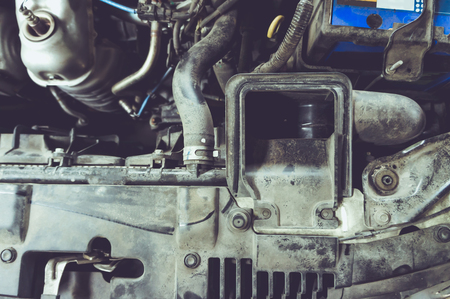1. Introduction to Exhaust Headers
Exhaust headers play a crucial role in an engines exhaust system by improving the way exhaust gases exit the cylinders. They are designed to increase engine efficiency and performance by reducing exhaust backpressure and improving exhaust flow.
What Are Exhaust Headers?
Exhaust headers are aftermarket or performance parts that replace a cars stock exhaust manifolds. Unlike stock manifolds, which are often made of heavy cast iron and have restrictive designs, headers are usually made of lightweight materials such as stainless steel and feature individual tubes for each cylinder, allowing exhaust gases to exit more efficiently.
The Purpose of Exhaust Headers
The primary function of headers is to optimize the exhaust flow from the engine, reducing restrictions and improving performance. Here are some of the key benefits:
| Benefit | Description |
|---|---|
| Improved Exhaust Flow | Headers help exhaust gases exit the engine more smoothly, reducing backpressure. |
| Increased Horsepower | By allowing the engine to expel exhaust gases more efficiently, headers can contribute to improved power output. |
| Enhanced Fuel Efficiency | With better exhaust flow, the engine doesnt have to work as hard, leading to potential fuel savings. |
| Better Engine Sound | Headers can alter and enhance the exhaust note, giving a deeper and more aggressive sound. |
The Role of Headers in the Exhaust System
Headers are a critical component of the performance exhaust system, working together with other parts like the catalytic converter, mid-pipe, and muffler. They ensure that exhaust gases are expelled efficiently, which improves overall engine performance and responsiveness.
How They Differ from Stock Manifolds
Stock exhaust manifolds are often designed to fit within tight engine bay spaces and keep manufacturing costs low. However, because they lack individual, equal-length tubes and have rough interior surfaces, they create turbulence and backpressure that can hinder performance. Headers, on the other hand, are designed for efficiency, helping exhaust gases escape quicker and reducing the engines workload.
Choosing the Right Exhaust Headers
Headers come in various designs, such as shorty and long-tube headers, each with its own advantages depending on your vehicle and performance goals. Understanding their role in the exhaust system can help in selecting the right type for maximum gains.
2. How Exhaust Flow Works
To understand how headers impact engine performance, its important to first grasp how exhaust gases move through the system. Your engine produces power by burning fuel and air in the combustion chambers, creating high-pressure exhaust gases that must exit efficiently. The faster and smoother these gases can escape, the better your engine breathes, which directly influences its performance.
Understanding Exhaust Gas Movement
When the air-fuel mixture ignites inside the engine, it creates an explosion that forces the piston downward. This process generates spent gases, which must be expelled before the next combustion cycle. These gases exit the engine through the exhaust valves and move into the exhaust manifold or headers.
Stock Manifolds vs. Performance Headers
Factory exhaust manifolds are typically made from cast iron and have a compact design. While they effectively channel exhaust gases, they often create backpressure, which can restrict engine efficiency. Performance headers, on the other hand, are designed to improve exhaust flow by allowing spent gases to exit with minimal resistance.
Key Differences Between Manifolds and Headers
| Feature | Stock Exhaust Manifold | Performance Headers |
|---|---|---|
| Material | Cast Iron | Stainless Steel or Ceramic-Coated Steel |
| Design | Short and compact | Longer, individual pipes for each cylinder |
| Performance | More restrictive, creates backpressure | Improved flow, reduces backpressure |
| Effect on Engine Power | Limited performance enhancement | Helps increase horsepower and torque |
How Headers Improve Exhaust Flow
Headers help optimize exhaust flow by using individual pipes for each cylinder, which allows gases to exit more smoothly. This reduces exhaust pulse interference, which can cause backpressure that hinders performance. With better gas flow, the engine can operate more efficiently, resulting in improved throttle response and power output.
Key Benefits of Headers
- Enhanced exhaust scavenging, which improves cylinder clearing.
- Reduced backpressure, allowing exhaust gases to escape faster.
- Boosted horsepower and torque output, especially at higher RPMs.
- Improved fuel efficiency by optimizing engine breathing.
Conclusion
By understanding how exhaust gases move through the system, it becomes clear why headers play a crucial role in performance. The improved exhaust flow provided by headers helps reduce backpressure and increase efficiency, making them a popular upgrade for enthusiasts looking to enhance their vehicle’s power and responsiveness.
![]()
3. Types of Headers and Their Impact
Headers come in different designs, each influencing exhaust flow and engine performance in unique ways. The primary types are short tube headers, long tube headers, and other specialized designs. Below, we compare how these headers affect horsepower, torque, throttle response, and overall efficiency.
Short Tube Headers
Short tube headers, also known as shorty headers, have shorter primary tubes that merge quickly into the collector. These headers are designed to improve exhaust scavenging while fitting in compact engine bays.
Benefits of Short Tube Headers
- Better than stock manifolds at improving exhaust flow
- Retains low-end torque
- Compatible with emissions systems
- Easier to install compared to long tube headers
Drawbacks of Short Tube Headers
- Limited horsepower gains at higher RPMs
- Not as effective as long tube headers in reducing backpressure
Long Tube Headers
Long tube headers have extended primary tubes that allow exhaust gases to travel a greater distance before merging. This design enhances high-RPM performance and is popular in racing and high-performance applications.
Benefits of Long Tube Headers
- Significantly improves high-RPM horsepower
- Reduces backpressure for better engine efficiency
- Enhances scavenging effect for improved airflow
Drawbacks of Long Tube Headers
- More complex installation due to space requirements
- May interfere with emissions compliance
- Reduction in low-end torque compared to short tube headers
Other Header Designs
In addition to short tube and long tube headers, there are other designs that provide different benefits depending on the application.
Tri-Y Headers
Tri-Y headers combine aspects of both short and long tube designs. They merge primary tubes in pairs before collecting into a final pipe, balancing low-end torque with high-RPM gains.
Equal Length vs. Unequal Length Headers
Equal length headers ensure that each exhaust pulse arrives at the collector at the same time, optimizing airflow. Unequal length headers, often used in turbocharged applications, create a distinct exhaust sound while maintaining good performance.
Comparison of Header Types
| Header Type | Main Benefit | Main Drawback | Best For |
|---|---|---|---|
| Short Tube Headers | Improved low-end torque | Limited high-RPM power gains | Street performance, daily driving |
| Long Tube Headers | Maximum high-RPM power | Reduced low-end torque, complex installation | Racing, high-performance builds |
| Tri-Y Headers | Balanced power throughout RPM range | More complex design | Versatile performance applications |
| Equal Length Headers | Optimized airflow efficiency | Space constraints | NA performance engines |
| Unequal Length Headers | Distinct sound, good for turbo applications | Less optimal exhaust pulse timing | Turbocharged vehicles |
Choosing the right header design depends on your vehicle’s engine setup, intended use, and performance goals. Understanding these differences helps in optimizing both power and efficiency.
4. Performance Benefits of Upgraded Headers
Upgrading to aftermarket headers can significantly enhance engine performance by improving horsepower, torque, and fuel efficiency. Let’s break down how these benefits come into play.
Increased Horsepower
Stock exhaust manifolds can restrict exhaust flow, creating backpressure that limits engine power. Aftermarket headers are designed to reduce this restriction, allowing exhaust gases to exit more efficiently. This improved exhaust flow helps the engine breathe better, leading to an increase in horsepower.
Improved Torque
Headers contribute to better scavenging, which is the process of expelling exhaust gases more effectively to make room for fresh air and fuel. This improves combustion efficiency, resulting in higher torque output, especially at low and mid-range RPMs. This is particularly beneficial for towing, off-roading, and high-performance driving.
Better Fuel Efficiency
By enhancing exhaust flow, aftermarket headers help the engine operate more efficiently. When the engine doesn’t have to work as hard to push out exhaust gases, it requires less fuel to generate power. While the improvement in fuel efficiency varies, many drivers notice a slight increase in miles per gallon (MPG), especially in highway driving.
Performance Comparison: Stock Manifolds vs. Aftermarket Headers
| Feature | Stock Exhaust Manifolds | Aftermarket Headers |
|---|---|---|
| Exhaust Flow | Restricted | Optimized for better flow |
| Horsepower Gains | Minimal | Noticeable increase |
| Torque Improvement | Limited | Enhanced, especially at low RPMs |
| Fuel Efficiency | Standard | Potential MPG improvement |
Choosing the Right Headers for Your Vehicle
Not all headers are created equal. Factors like primary tube length, material, and design (shorty vs. long-tube headers) will influence their effectiveness. Long-tube headers typically provide more horsepower and torque gains at higher RPMs, while shorty headers are better for low-end power and easier installation.
Final Thoughts on Performance Gains
Investing in aftermarket headers is a great way to boost engine performance. Whether youre looking for more power, increased torque, or better fuel economy, upgrading your headers can make a noticeable difference in how your vehicle performs on the road.
5. Potential Drawbacks and Considerations
While upgrading to performance headers can improve exhaust flow and engine performance, there are some potential downsides to consider. Here are a few key factors to keep in mind before making the upgrade.
Installation Complexity
Installing headers can be challenging, especially for vehicles with limited engine bay space. Factory exhaust manifolds are often designed for ease of installation, while aftermarket headers may require modifications, such as rerouting other components or adjusting the exhaust system. Additionally, some headers require special gaskets or hardware, further complicating the installation process.
Emissions Concerns
One major factor to consider is how headers affect emissions compliance. Many stock exhaust manifolds are designed with built-in catalytic converters to help reduce emissions. Replacing them with aftermarket headers may cause the vehicle to fail emissions tests, making it illegal to drive in certain states with strict emission regulations. Always check local laws before installing aftermarket headers.
Cost Factors
Headers come in a wide price range, and high-quality performance headers can be expensive. Additionally, installation costs can add up if professional help is needed. Below is a general cost comparison:
| Type of Headers | Approximate Cost | Installation Complexity |
|---|---|---|
| Shorty Headers | $200 – $600 | Moderate |
| Long Tube Headers | $500 – $1,500+ | High |
In addition to the initial cost, some headers may require tuning adjustments to optimize performance, adding to the overall expense. Consider your budget and whether the performance gains justify the investment.
6. Conclusion: Choosing the Right Headers
Selecting the right headers for your vehicle depends on several key factors, including the type of vehicle, your performance goals, and your budget. Headers come in different designs, materials, and sizes, each affecting engine performance in unique ways.
Vehicle Type
Different vehicles require different types of headers. For example, a daily driver may benefit from shorty headers that offer a balance between performance and emissions compliance. In contrast, a high-performance race car might require long-tube headers for maximum horsepower gains.
Performance Goals
Your choice of headers should match your desired performance outcome. If you’re looking to improve low-end torque, shorty headers might be a better fit. If increasing horsepower at high RPMs is your goal, long-tube headers offer the best performance gains.
Budget Considerations
Headers come in a wide range of prices, from budget-friendly options to high-end performance models. Stainless steel headers tend to be more expensive but are durable and resistant to corrosion. Ceramic-coated headers provide better heat management, while mild steel options are more affordable but may not last as long.
Comparison of Header Types
| Header Type | Best For | Pros | Cons |
|---|---|---|---|
| Shorty Headers | Daily drivers, minor performance upgrades | Easy installation, better low-end torque, emissions-friendly | Less horsepower gain compared to long-tube headers |
| Long-Tube Headers | High-performance applications, racing | Significant horsepower gain, better exhaust scavenging | More challenging installation, may require emissions modifications |
| Stainless Steel | Long-lasting performance, corrosion resistance | Durable, resistant to rust | More expensive |
| Ceramic-Coated | Performance with better heat control | Reduces under-hood temperature, protects components | Higher cost |
| Mild Steel | Budget-friendly performance upgrade | Affordable, easier to work with | Prone to rust over time |
Making the Right Choice
When choosing headers, consider how your vehicle is used, what level of performance gain you’re looking for, and how much you’re willing to spend. If you need a straightforward upgrade with an easy installation process, shorty headers might be the way to go. For those who want maximum performance and don’t mind a more complex installation, long-tube headers deliver the best results.
Final Thoughts
Ultimately, the right headers will depend on balancing your goals with practical considerations such as cost, ease of installation, and long-term durability. By understanding how different headers affect exhaust flow and engine performance, you can make an informed decision that enhances your driving experience.


